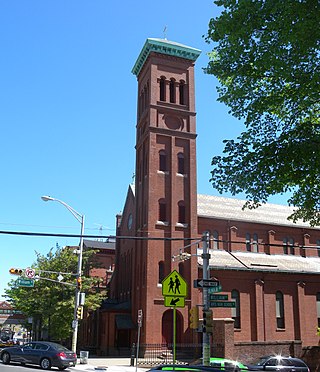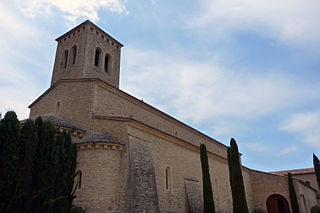
The Benedictines, officially the Order of Saint Benedict, are a mainly contemplative monastic religious order of the Catholic Church for men and for women who follow the Rule of Saint Benedict. The male religious are also sometimes called the Black Monks, in reference to the colour of their religious habits, in contrast to other Benedictine orders such as the Olivetans, who wear white. They were founded in 529 by Benedict of Nursia, a 6th-century Italian monk who laid the foundations of Benedictine monasticism through the formulation of his Rule. Benedict's sister, Scholastica, possibly his twin, also became a religious from an early age, but chose to live as a hermit. They retained a close relationship until her death.

The Rule of Saint Benedict is a book of precepts written in Latin c. 530 by St Benedict of Nursia for monks living communally under the authority of an abbot.

The Trappists, officially known as the Order of Cistercians of the Strict Observance and originally named the Order of Reformed Cistercians of Our Lady of La Trappe, are a Catholic religious order of cloistered monastics that branched off from the Cistercians. They follow the Rule of Saint Benedict and have communities of both monks and nuns that are known as Trappists and Trappistines, respectively. They are named after La Trappe Abbey, the monastery from which the movement and religious order originated. The movement first began with the reforms that Abbot Armand Jean le Bouthillier de Rancé introduced in 1664, later leading to the creation of Trappist congregations, and eventually the formal constitution as a separate religious order in 1892.
Lay brother is a largely extinct term referring to religious brothers, particularly in the Catholic Church, who focused upon manual service and secular matters, and were distinguished from choir monks or friars in that they did not pray in choir, and from clerics, in that they were not in possession of holy orders.

In Western Christianity, Lectio Divina is a traditional monastic practice of scriptural reading, meditation and prayer intended to promote communion with God and to increase the knowledge of God's word. In the view of one commentator, it does not treat Scripture as texts to be studied, but as the living word.

Cluny Abbey is a former Benedictine monastery in Cluny, Saône-et-Loire, France. It was dedicated to Saint Peter.

The Abbey of Our Lady, Help of Christians, commonly known as Worth Abbey, is a community of Roman Catholic monks who follow the Rule of St Benedict near Turners Hill village, in West Sussex, England. Founded in 1933, the abbey is part of the English Benedictine Congregation. As of 2020, the monastic community had 21 monks.

The Abbey of Ealing is a Roman Catholic Benedictine monastery located on Castlebar Hill in Ealing, United Kingdom. It is part of the English Benedictine Congregation.

Westminster Abbey is a community of Benedictine monks in Mission, British Columbia, established in 1939 from the Abbey of Mount Angel, Oregon. The abbey is home to the Seminary of Christ the King and is a member of the Swiss American Congregation within the Benedictine Confederation.

Saint John's Abbey is a Benedictine monastery in Collegeville Township, Minnesota, United States, affiliated with the American-Cassinese Congregation. The abbey was established following the arrival in the area of monks from Saint Vincent Archabbey in Pennsylvania in 1856. Saint John's is one of the largest Benedictine abbeys in the Western Hemisphere, with 110 professed monks. The Right Reverend Fr. Doug Mullin, OSB, serves as the eleventh abbot.

Mount Saint Benedict Abbey, also known as The Abbey of Our Lady of Exile is a Benedictine monastery following the Order of Saint Benedict. This monastery is located in the northwestern town of St. Augustine in Tunapuna–Piarco in Trinidad and Tobago.

St. Gregory's Abbey is an American monastic community of men living under the Rule of St. Benedict within the Episcopal Church. The abbey is located near Three Rivers in St. Joseph County, Michigan.

The Abbey of Saint Mary and Saint Louis is an abbey of the Catholic English Benedictine Congregation (EBC) located in Creve Coeur, in St. Louis County, Missouri in the United States. The Abbey is an important presence in the spiritual life of the Archdiocese of St. Louis. The monks of the Abbey live their faith according to the Benedictine discipline of 'prayer and work', praying the Divine Office five times daily, celebrating daily Masses in English and Latin, and working in the two parishes under their pastoral care and in the Saint Louis Priory School, which the Abbey runs as an apostolate. The Abbey and its school sit on a 150-acre (0.61 km2) campus in west St. Louis County, in the city of Creve Coeur.

Saint Joseph Abbey is a Benedictine abbey in Saint Benedict, Louisiana, governed by the Swiss-American Congregation of the Benedictine Confederation. The monks of the abbey also operate Saint Joseph Seminary College.

Silverstream Priory is a Roman Catholic monastery in Stamullen, County Meath, Ireland, founded in 2012. The monastery is an autonomous diocesan priory of the Benedictine Monks of Perpetual Adoration.

St. Andrew Abbey-Cleveland is a Benedictine monastery in Cleveland, Ohio.

St. Benedictusberg Abbey, also Mamelis Abbey, is a Benedictine monastery established in 1922 in Mamelis, a hamlet which administratively falls within Vaals, Netherlands. It is a rijksmonument.

Newark Abbey, also known as The Benedictine Abbey of Newark, is a Benedictine monastery located in Newark, New Jersey. It is one of only several urban Catholic monasteries in the country. The monks serve the community through Saint Benedict's Preparatory School and St. Mary's Abbey Church, which are situated on the Abbey grounds. As of 2022, the community is composed of seventeen monks, including eleven priests.

The abbey of Sainte-Madeleine du Barroux also known as Le Barroux Abbey is a traditionalist Benedictine abbey located in Le Barroux, Vaucluse, France. It was founded in 1978 by Dom Gérard Calvet while the current abbot is Dom Louis-Marie de Geyer d’Orth.


















